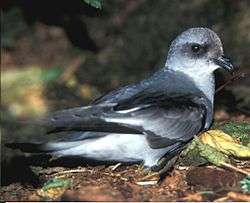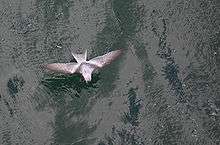Fork-tailed storm petrel
| Fork-tailed storm petrel | |
|---|---|
 | |
| Scientific classification | |
| Kingdom: | Animalia |
| Phylum: | Chordata |
| Class: | Aves |
| Order: | Procellariiformes |
| Family: | Hydrobatidae |
| Subfamily: | Hydrobatinae |
| Genus: | Oceanodroma |
| Species: | O. furcata |
| Binomial name | |
| Oceanodroma furcata (Gmelin, 1789) | |
The fork-tailed storm petrel (Oceanodroma furcata) is a small seabird of the storm petrel family Hydrobatidae. It is 20 to 23 centimetres (7.9 to 9.1 in) in length, with a wingspan of 46 cm. It is the only storm-petrel gray in color.
In North America, it breeds on islands on the Aleutian Islands off Alaska, and on islands along the coasts of British Columbia in Canada and the Pacific Northwest in the United States. The fork-tailed storm petrel also breeds on the Kuril Islands off Kamchatka. This bird breeds in rock crevices or small burrows in soft earth and lays a single white egg that measures around 35 by 25 millimetres (1.38 by 0.98 in). This egg is incubated for 43 to 57 days, with the temperature required for incubation is 13 °F (−11 °C) lower than required for most birds.[2] Like most petrels, its walking ability is limited to a short shuffle to the burrow. It is a colonial nester.


It spends the rest of the year at sea, usually spending its time over colder waters. It can be seen well offshore down the Pacific coast to central California on the North American side, and down to Japan on the Asian side.
It feeds on mainly planktonic crustaceans, small fish and squid. It will also take offal. It feeds similarly to other storm-petrels, picking food of the surface of the water while in flight. This bird does follow ships.
References
- ↑ BirdLife International (2012). "Oceanodroma furcata". IUCN Red List of Threatened Species. Version 2013.2. International Union for Conservation of Nature. Retrieved 26 November 2013.
- ↑ Hauber, Mark E. (1 August 2014). The Book of Eggs: A Life-Size Guide to the Eggs of Six Hundred of the World's Bird Species. Chicago: University of Chicago Press. p. 47. ISBN 978-0-226-05781-1.
| Wikimedia Commons has media related to Oceanodroma furcata. |
- "National Geographic" Field Guide to the Birds of North America ISBN 0-7922-6877-6
- Seabirds, an Identification Guide by Peter Harrison, (1983) ISBN 0-7470-1410-8
- Handbook of the Birds of the World Vol 1, Josep del Hoyo editor, ISBN 84-87334-10-5
- "National Audubon Society" The Sibley Guide to Birds, by David Allen Sibley, ISBN 0-679-45122-6
